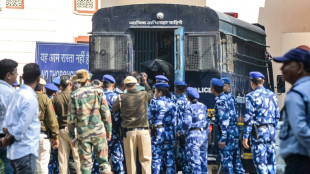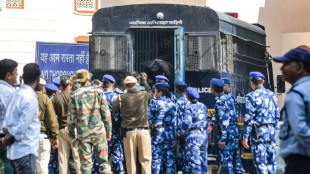
-
 LeBron back in training, edges closer to Lakers return
LeBron back in training, edges closer to Lakers return
-
Climate talks run into night as COP30 hosts seek breakthrough

-
 Germany and Netherlands lock up World Cup spots in style
Germany and Netherlands lock up World Cup spots in style
-
Germany's Woltemade hopes for 2026 World Cup spot after scoring again

-
 Germany 'send message' with Slovakia rout to reach 2026 World Cup
Germany 'send message' with Slovakia rout to reach 2026 World Cup
-
Trump unveils fast-track visas for World Cup ticket holders

-
 Netherlands qualify for World Cup, Poland in play-offs
Netherlands qualify for World Cup, Poland in play-offs
-
Germany crush Slovakia to qualify for 2026 World Cup

-
 Stocks gloomy on earnings and tech jitters, US rate worries
Stocks gloomy on earnings and tech jitters, US rate worries
-
'In it to win it': Australia doubles down on climate hosting bid

-
 Former NFL star Brown could face 30 yrs jail for shooting case: prosecutor
Former NFL star Brown could face 30 yrs jail for shooting case: prosecutor
-
Fate of Canada government hinges on tight budget vote

-
 New research measures how much plastic is lethal for marine life
New research measures how much plastic is lethal for marine life
-
Mbappe, PSG face off in multi-million lawsuit

-
 EU defends carbon tax as ministers take over COP30 negotiations
EU defends carbon tax as ministers take over COP30 negotiations
-
McCartney to release silent AI protest song

-
 Stocks tepid on uncertainty over earnings, tech rally, US rates
Stocks tepid on uncertainty over earnings, tech rally, US rates
-
Louvre shuts gallery over ceiling safety fears

-
 'Stranded, stressed' giraffes in Kenya relocated as habitats encroached
'Stranded, stressed' giraffes in Kenya relocated as habitats encroached
-
US Supreme Court to hear migrant asylum claim case

-
 Western aid cuts could cause 22.6 million deaths, researchers say
Western aid cuts could cause 22.6 million deaths, researchers say
-
Clarke hails Scotland 'legends' ahead of crunch World Cup qualifier

-
 S.Africa says 'suspicious' flights from Israel show 'agenda to cleanse Palestinians'
S.Africa says 'suspicious' flights from Israel show 'agenda to cleanse Palestinians'
-
South Korea pledges to phase out coal plants at COP30

-
 Ex-PSG footballer Hamraoui claims 3.5m euros damages against club
Ex-PSG footballer Hamraoui claims 3.5m euros damages against club
-
Mbappe, PSG in counterclaims worth hundreds of millions

-
 Two newly discovered Bach organ works unveiled in Germany
Two newly discovered Bach organ works unveiled in Germany
-
Stocks lower on uncertainty over earnings, tech rally, US rates

-
 Barca to make long-awaited Camp Nou return on November 22
Barca to make long-awaited Camp Nou return on November 22
-
COP30 talks enter homestretch with UN warning against 'stonewalling'

-
 France makes 'historic' accord to sell Ukraine 100 warplanes
France makes 'historic' accord to sell Ukraine 100 warplanes
-
Delhi car bombing accused appears in Indian court, another suspect held

-
 Emirates orders 65 more Boeing 777X planes despite delays
Emirates orders 65 more Boeing 777X planes despite delays
-
Ex-champion Joshua to fight YouTube star Jake Paul

-
 Bangladesh court sentences ex-PM to be hanged for crimes against humanity
Bangladesh court sentences ex-PM to be hanged for crimes against humanity
-
Trade tensions force EU to cut 2026 eurozone growth forecast

-
 'Killed without knowing why': Sudanese exiles relive Darfur's past
'Killed without knowing why': Sudanese exiles relive Darfur's past
-
Stocks lower on uncertainty over tech rally, US rates

-
 Death toll from Indonesia landslides rises to 18
Death toll from Indonesia landslides rises to 18
-
Macron, Zelensky sign accord for Ukraine to buy French fighter jets

-
 India Delhi car bomb accused appears in court
India Delhi car bomb accused appears in court
-
Bangladesh ex-PM sentenced to be hanged for crimes against humanity

-
 Leftist, far-right candidates advance to Chilean presidential run-off
Leftist, far-right candidates advance to Chilean presidential run-off
-
Bangladesh's Hasina: from PM to crimes against humanity convict

-
 Rugby chiefs unveil 'watershed' Nations Championship
Rugby chiefs unveil 'watershed' Nations Championship
-
EU predicts less eurozone 2026 growth due to trade tensions

-
 Swiss growth suffered from US tariffs in Q3: data
Swiss growth suffered from US tariffs in Q3: data
-
Bangladesh ex-PM sentenced to death for crimes against humanity

-
 Singapore jails 'attention seeking' Australian over Ariana Grande incident
Singapore jails 'attention seeking' Australian over Ariana Grande incident
-
Tom Cruise receives honorary Oscar for illustrious career


Roads, farming threaten Ecuador 'lost city' complex
Shielded by the jungle for hundreds of years, the remains of a massive 2,500-year-old network of Ecuadoran cities are being threatened by road and farm encroachment just as its long-held secrets are being revealed, researchers say.
Traces of an Amazonian "lost city" were first discovered in 1978, but the full extent of what is now believed to be the largest and oldest such urban expanse were only revealed last year with the help of laser mapping.
The vast site, which covers more than 1,000 square kilometers (385 square miles), lies deep in the Upano valley on the foothills of the Andes mountain range in eastern Ecuador.
It consists of ancient settlements of different sizes, connected by what researchers describe as a complex system of roads.
Archeologists have also identified some 7,400 mounds in various shapes, made by human hands millennia ago.
They stand up to four meters (about 13 feet) tall and five times as wide and are believed to have been the foundations of homes, or communal areas for rituals or festivals.
Some have already been damaged -- wrongly thought by road developers to be natural formations that they could break through.
"There is an urgent need... for a protection plan," said Spanish archeologist Alejandra Sanchez, who has been studying the site for a decade.
Beyond the road construction issue, Sanchez also described the risks posed by erosion, deforestation, and agriculture to the mounds, which she said are "destroyed very easily by rain, wind, plows."
The Upano River, cradle of the Indigenous culture of the same name, is also the victim of voracious mining, both legal and wildcat.
- 'The tip of the iceberg' -
As a first step towards having the site protected, Ecuador's National Institute of Cultural Heritage (INPC) is working on delineating the complex.
The INPC in 2015 started mapping out the area using LiDAR (Light Detection and Ranging) technology, bouncing laser light off buildings or trees to measure landscapes.
The data was shared with archeologists in 2021.
Last year, Sanchez and Argentine researcher Rita Alvarez presented their analysis of the images in an INPC publication.
Then in January, a French-led team reported their own findings based on the mapping data in the journal Science -- giving global news coverage to the discovery.
The site was first described by priest and archeologist Pedro Porras in the 1980s, according to the private Catholic University's Weilbauer-Porras museum in Quito, which displays finely decorated red-tinted vessels, and a piece of volcanic rock carved in a half-human, half-animal shape.
It also houses maps and black-and-white photographs of Porras pointing to the mounds protruding from the ground.
According to researchers who have studied the city network since the 1980s, the Upano people who built it had the political, economic, and religious organization typical of great civilizations.
Construction on the mounds is thought to have begun between 500 BC and 300-600 AD -- around the time of the Roman empire.
Other urban sites discovered in the Amazon date from between 500-1,500 AD.
And while Ecuador may once have "envied" the archeological riches of other Latin American nations, the Upano site matches them in "quantity, grandeur, history and cultural expression," archaeologist Alden Yepez of the Catholic University told AFP.
He believes discoveries so far are only "the tip of the iceberg" of an even bigger civilization, and that the site may extend up to 2,000 square km around the Upano, Palora and Pastaza rivers, where there are also signs of settlements.
"The idea that the Amazon was an unpopulated space or only inhabited by nomads has been discarded," said INPC director Catalina Tello.
S.Abdullah--SF-PST




